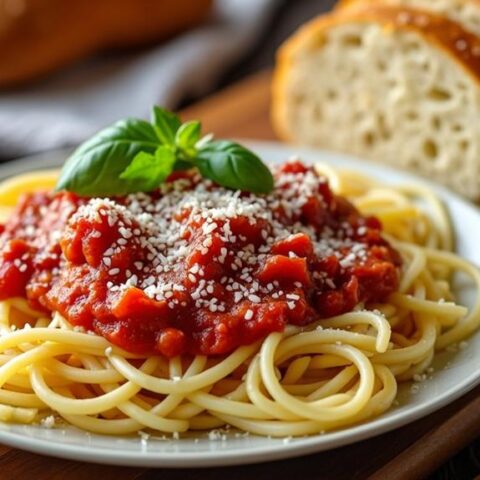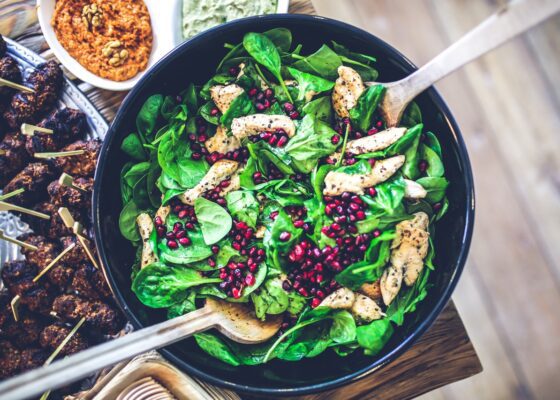
Pure meat sausages typically contain minimal carbohydrates, with most varieties having 0-6 grams per 100-gram serving. However, processed sausages often include hidden carb sources through additives like breadcrumbs, corn syrup, and binding agents. For lowest carb content, consumers should choose products with 95% or higher meat content and carefully examine nutrition labels for hidden ingredients. Traditional varieties like Italian sausage and chorizo remain reliable low-carb options, though understanding proper selection criteria guarantees ideal dietary success.
Key Takeaways
- Pure meat sausages with 95% or higher meat content typically contain only 0-6 grams of carbs per 100-gram serving.
- Hidden carbs often come from binding agents like breadcrumbs, corn syrup, and potato flour added during processing.
- Traditional breakfast sausages and varieties like Italian sausage and chorizo generally contain around 1 gram of carbs.
- Always check nutrition labels for total carbohydrates and inspect ingredient lists for hidden sugars and binders.
- Flavored sausage varieties may contain significantly more carbs due to added ingredients and fruit-based sweeteners.
Understanding Sausage Types and Their Carb Content
While many people following low-carb diets often question whether sausage fits into their meal plans, the carbohydrate content of sausages varies notably depending on the type and preparation method.
Pure meat sausages, containing at least 95% pork, beef, or chicken, typically offer the lowest carb content, ranging from 0 to 6 grams per 100-gram serving.
However, manufacturers often incorporate additional ingredients like breadcrumbs or corn syrup as binders, which can notably increase the carb count.
Traditional breakfast sausages generally contain around 1 gram of carbs, while flavored varieties may pack higher amounts due to added ingredients.
To maintain a low carb diet, consumers should carefully examine the nutritional label before purchase, focusing on sausages with minimal fillers and the highest pure meat content.
Hidden Sources of Carbohydrates in Sausages
While sausages may appear to be naturally low in carbohydrates, manufacturers often incorporate binding agents and fillers that can substantially increase the carb content.
Common additives like breadcrumbs, potato flour, and corn syrup can contribute hidden carbohydrates that may not be immediately apparent to consumers.
Careful examination of nutrition labels becomes essential for those following low-carb diets, as even products marketed as "low carb" may contain unexpected sources of carbohydrates through these binding agents and flavor enhancers.
Binders and Fillers Impact
Many sausage varieties contain hidden sources of carbohydrates through binders and fillers that manufacturers commonly add during production.
Common ingredients like breadcrumbs, potato flour, and corn syrup can greatly increase carbs per sausage, with corn syrup alone contributing up to 30 grams of carbohydrates per 2 tablespoons.
Even products marketed as low-carb may include unexpected added ingredients such as essential wheat gluten and soy flour, which can compromise dietary goals.
Careful examination of nutrition labels is important, as carbohydrate content can range from 0 to 6 grams per 100-gram serving.
For those seeking truly low-carb options, it's imperative to select sausages with at least 95% meat content and avoid products containing fruit flavorings, which can increase sugar levels.
Label Reading Essentials
Understanding sausage nutrition labels requires careful attention to detail, as manufacturers often include carbohydrate-rich ingredients that may not be immediately apparent to shoppers.
When examining labels, consumers should specifically look for hidden sources of carbohydrates, such as corn syrup, which can contribute up to 30 carbs per 2 tablespoons to the product. Various binders like flour, soy flour, and essential wheat gluten also increase carbohydrate content considerably.
To maintain a low carb intake, shoppers should read labels carefully and select sausages containing at least 95% meat with minimal added fillers.
Pay particular attention to flavored varieties, which may contain unexpected sugars from fruit additions or sweeteners. By being vigilant about ingredient lists, consumers can better identify and avoid sausages with higher carbohydrate content.
Best Low-Carb Sausage Varieties for Your Diet
Several excellent sausage varieties fit perfectly into a low-carb eating plan, with most containing between 0-2 grams of carbohydrates per 100-gram serving. Traditional options like pork, beef, and chicken sausage stand out as ideal choices for those monitoring their carb intake. Italian sausage and chorizo, each containing approximately 1 gram of carbs per serving, offer flavorful alternatives while maintaining low-carb status. When selecting processed meats like sausage, consumers should prioritize products with 95% or higher meat content to avoid unnecessary carb-heavy ingredients. While breakfast sausage links typically contain just 1 gram of carbs, it's essential to carefully review labels on specialty varieties. Some flavored options, particularly those incorporating fruits or added sugars, may include higher carbohydrate levels that could affect dietary goals.
Reading Labels: What to Look for When Buying Sausages
The key to selecting truly low-carb sausages lies in mastering the art of label reading at the grocery store. When examining nutritional labels, shoppers should first locate the grams of carbs per serving and check for added sugars or fillers that could increase carbohydrate content. It's essential to look for products with a high percentage of meat, preferably 95% or higher, as this indicates fewer carb-heavy fillers. To determine the actual carbohydrate impact, calculate net carbs by subtracting dietary fiber from total carbohydrates. Fermented dairy products like yogurt can also be a beneficial addition to a low-carb diet as they promote digestive health. Choose preservative-free options from natural brands, which typically contain fewer additives and unnecessary carbohydrates. Watch out for binding agents like corn syrup or breadcrumbs, which can greatly increase the carb content of otherwise protein-rich sausages.
The Impact of Processing Methods on Carb Content
While sausage processing methods have evolved over centuries, modern manufacturing techniques can greatly influence the carbohydrate content of the final product. Understanding how various processing methods affect carb content is essential for consumers monitoring their carbohydrate intake.
- Curing processes may include sugar-based compounds that increase carb content.
- Type of binding agents like wheat gluten or potato flour directly impact total carbs.
- Traditional smoking techniques generally don't add carbs, but liquid smoke flavoring might contain sugars.
- Fillers and extenders found in highly processed varieties can considerably raise carb levels.
- Extra lean varieties often compensate for fat reduction by adding carb-heavy ingredients.
When selecting sausages, carefully check nutrition labels for ingredients that could increase carbohydrates. Products with minimal processing and higher meat content typically offer the lowest carb options.
Making Smart Choices at the Butcher Counter
Selecting sausages at the butcher counter requires careful attention to both ingredient labels and meat content percentages, with an emphasis on products containing 95% or more pure meat.
Shoppers should examine nutritional labels for carbohydrate content and scrutinize ingredient lists for binding agents like breadcrumbs or corn syrup, which can substantially increase the carb count.
The most reliable approach involves consulting directly with butchers about their low-carb sausage options, particularly focusing on pure meat varieties that typically contain only 1-2 grams of carbs per serving.
For a keto-friendly diet, prioritize sausages made from fresh meats and poultry, as they are almost carb-free and rich in essential nutrients.
Reading Sausage Labels Wisely
Smart shopping for low-carb sausages begins with carefully examining nutrition labels and ingredient lists at the butcher counter. When selecting sausages, consumers should focus on products with high meat content and minimal fillers to guarantee the lowest possible carbohydrate content.
Key points to check on sausage labels:
- Total carbohydrates per serving
- Percentage of meat content (aim for 95% or higher)
- Presence of added sugars or fruit ingredients
- Type of binding agents used (like soy flour or wheat gluten)
- Hidden high-carb fillers and preservatives
Vigilant label reading helps identify the most suitable low-carb sausage options. Flavored varieties often contain additional carbohydrates, so paying extra attention to their ingredients list is vital.
Consulting with knowledgeable butchers can provide valuable insights into selecting the most appropriate low-carb sausage varieties.
Choosing Quality Meat Content
Three essential factors determine the quality of sausage meat content at the butcher counter: lean-to-fat ratio, meat source authenticity, and processing methods. When considering different meats including beef for a keto diet, selecting sausages with at least 95% quality meat content helps maintain daily carb limits.
| Type | Characteristics | Best For |
|---|---|---|
| Pure Meat | No fillers, natural casings | Keto diet |
| Mixed | Contains breadcrumbs, additives | Higher carb tolerance |
| Flavored | Added fruits, sugars | Occasional treats |
When buying sausages, discuss ingredient specifications with your butcher, focusing on varieties made without high-carb additives. Premium brands like Premio Foods offer reliable options for those monitoring their carb intake. Always check labels for preservatives and hidden sugars that could affect your dietary goals.
Low-Carb Sausage Meal Planning and Preparation
Successful low-carb meal planning with sausage requires careful attention to both ingredient selection and preparation methods. When incorporating different types and styles of sausage into meals, prioritize options containing minimal fillers like breadcrumbs and pair them with low-carb vegetables for peak nutritional balance. Reading nutritional labels carefully helps guarantee per-serving carbohydrate content aligns with dietary goals.
- Choose sausages with 95% or higher meat content
- Pair with zucchini noodles or cauliflower rice
- Freeze in 1 lb portions for controlled meal preparation
- Check labels for hidden sugars and binders
- Explore various cooking methods like grilling or baking
These strategies help maintain low-carb integrity while creating flavorful, satisfying meals that support dietary goals and provide variety in texture and taste. Incorporating healthy fats such as olive oil or avocado oil when cooking sausages can enhance both the flavor and nutritional profile of your meals.
Health Considerations for Regular Sausage Consumption
While incorporating sausage into low-carb meals can be effective for dietary planning, understanding the health implications of regular consumption remains important for making informed dietary choices. Regular consumption of processed sausages presents several health considerations due to their composition and preparation methods. High sodium levels in these products can contribute to cardiovascular issues, while nitrates and nitrites used as preservatives have been linked to potential long-term health risks. Additionally, some sausages contain hidden carbohydrate content through binders and fillers, which may affect blood sugar management. The key to safely enjoying sausages lies in moderation and selecting higher-quality options with minimal processing. Balancing sausage consumption with plenty of vegetables and whole foods can help mitigate potential health concerns while maintaining dietary goals. It's also important to consider genetic factors that play a crucial role in determining individual responses to dietary changes, as they may impact how different people react to regular sausage consumption and its effects on health.
Frequently Asked Questions
Are Sausages Ok on a Low-Carb Diet?
Most sausages are suitable for low-carb diets, featuring minimal carb content and high protein source value. Checking sausage ingredients, practicing portion control, and choosing appropriate cooking methods guarantees peak nutritional value.
Will Sausage Kick Me Out of Ketosis?
Most sausages won't disrupt ketosis when carb content remains low. However, checking ingredients for sugar additives is essential. Pure protein sources and high fat levels make traditional sausages generally ketosis-friendly.
Can You Eat Sausages on a Slow Carb Diet?
Sausage types with minimal carb content can fit into a slow carb diet. Reading nutritional labels helps identify suitable options. Grilled or baked sausages, paired with vegetables, work well in moderate serving sizes.
Can I Eat Sausage While Trying to Lose Weight?
Sausage can support weight loss when combined with proper portion control and calorie counting. As a protein source, it fits into balanced meal planning, though leaner, healthy alternatives may offer better nutritional value.
Conclusion
While traditional sausages can be part of a low-carb diet, careful label reading and mindful selection remain essential for success. Pure meat sausages typically contain minimal carbohydrates, but processed varieties often include hidden sugars and fillers. By choosing high-quality products, understanding ingredient lists, and prioritizing sausages from trusted butchers, consumers can enjoy these protein-rich foods while maintaining their dietary goals. Moderation and awareness are key to incorporating sausages into a healthy low-carb lifestyle.










No Comments